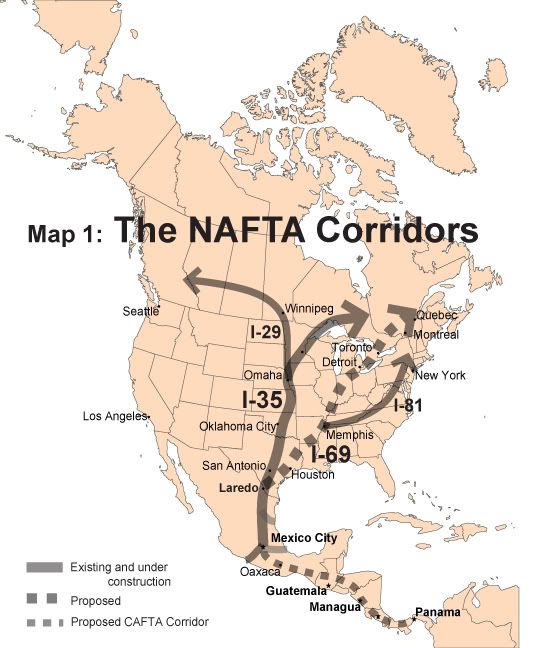“After a dozen town hall meetings, nearly 50 public hearings, and countless one-on-one conversations, it is clear to us that Texans want us to use existing roadways to start building the Texas portion of Interstate 69,” said Texas Transportation Commissioner Ted Houghton (Texas Department of Transportation News Release, June 11, 2008).
This news release reflects both good news and bad news about the neo-conservative plan to construct massive NAFTA super-corridors from Mexico to Canada and operate them as private toll roads.
Map 1 presents a geographic overview of those plans:
The original plan for the I-35 super-corridor was to parallel existing Interstate 35 from the inland port of Laredo, Texas north to the US-Canadian border at Duluth, Minnesota. Sections of the I-35 super-corridor are under construction or have been completed, including tolled sections, and the volume of traffic is increasing along the entire route.
The proposed I-69 NAFTA corridor was also to originate at Laredo, cut in a northeasterly direction through the center of the Midwest, and cross into Canada at Port Huron just north of Detroit. The I-69 super-corridor plan was a grandiose scheme to build a 1,200 foot-wide transportation corridor that would consume thousands of acres of some of the best agricultural land and remaining wilderness in Texas, Arkansas, Tennessee, Kentucky, Indiana, and Michigan.
The multiple purposes of both I-35 and I-69 were the same:
- To import raw materials and goods produced in Mexico to the lucrative markets of the Midwest
- To establish a southern route for merchandise produced in the Far East and imported through Mexico in order to bypass the unionized ports of the US West Coast
- To develop the transportation infrastructure to accommodate the massive influx of workers from the Global South under pending US and Canadian guest worker programs
- To export goods, primarily agricultural products, from the Midwest to Mexico
- To privatize the main mid-continental lines of transportation and monopolize transport-related business along the route
The Good News
The good news is that the I-69 super-corridor plan has suffered a resounding defeat at the hands of the citizens of Texas where the NAFTA corridors project was initiated.
After Governor Rick Perry signed an exclusive development agreement with Cintra Concesiones de Infrastructures de Transportate, S.A. of Madrid, Spain in 2005 for the Texas leg of the NAFTA super-corridors, the Texas Department of Transportation (TxDOT) was tasked with trumping up public consensus for the comprehensive privatization plan.
TxDOT’s efforts were in vain. The town hall meetings, public hearings, and personal encounters between TXDOT officials and the public were not as cordial as the statement by TxDOT Commissioner Houghton might suggest.
In fact, most of the public meetings were openly antagonistic confrontations between the agents of the neo-cons in the Texas government sent to hold the line and angry citizens who were opposed to the seizure of land for private profit, dead-set against the privatization of public transportation, and concerned about the environmental impact of the massive project.
The neo-cons lost the contest and the open revolt spread, forcing elected officials at all level of government to respond to the rising voice of the people. In 2007, the Texas Legislature voted to impose a two-year moratorium on long-term privately operated toll projects in the state.
The people won the first round and continued the fight until in early June TxDOT officially announced the abandonment of the I-69 corridor plan.
The Bad News
The bad news is that the grassroots revolt against the super-corridor plan, as successful as it was, addressed the symptoms and not the causes of the current economic and political crises that are developing in Texas and the nation at large.
The crisis of US capitalism and the push to accelerate the pace of globalization to meet that crisis, along with the collateral damage inflicted on the communities of working people and the environment, continue unabated. The defeat of the I-69 corridor plan will not stop the flood of cheap merchandise from the Global South and Far East or the massive influx of workers from the South if a massive guest worker programs is initiated. The backup plan is to route the increasing traffic through a patchwork of existing highways and expanded right-of-ways through countless small towns as well as major metropolitan centers like Houston, Memphis, and Indianapolis.
Obviously, the fight is far from over but now we have powerful experience to learn from.
Power to the People
The defeat of the I-69 plan in Texas is an important victory. It shows that the common people of the US are not powerless vis-à-vis the government which has been sized by big capital at every level. The fight against the I-69 corridor was a true grassroots campaign conducted by community and environmental activists, ranchers, farmers, homeowners, and small-businesspeople using their personal and community resources to fight a good fight. They employed technology to gather and share information, create and distribute educational videos, and organize and activate political networks.
Overall, the campaign against the I-69 super-corridor was an impressive expression of people power. Perhaps we are approaching an era in which the call for “Power to the People” will not be the desperate cry of isolated and marginalized groups but the rallying cry for genuine democracy in the US.
Richard D. Vogel is a political reporter who monitors the effects of globalization on working people and their communities. Other works include: “Stolen Birthright: The U.S. Conquest and Exploitation of The Mexican People”; “The NAFTA Corridors: Offshoring U.S. Transportation Jobs to Mexico”; “Transient Servitude: The U.S. Guest Worker Program for Exploiting Mexican and Central American Workers”; and “The Fight of Our Lives: The War of Attrition against U.S. Labor.” Contact: <[email protected]>.
|
| Print

